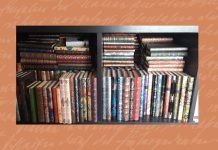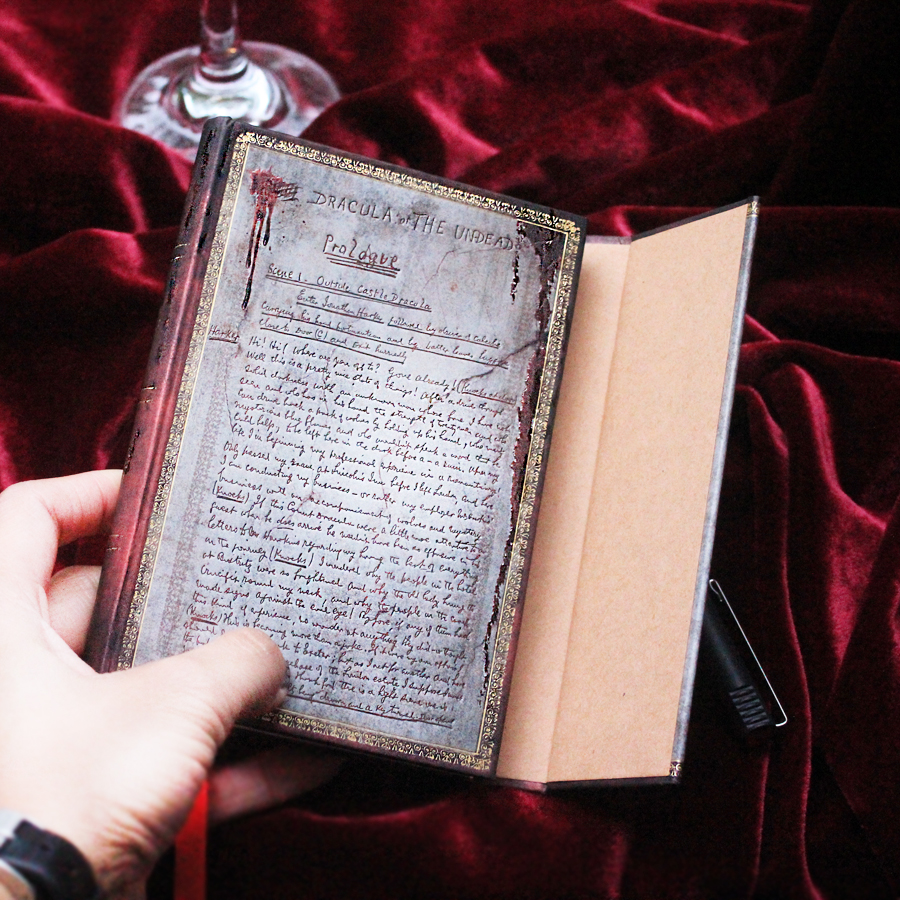Today in our #PeopleOfPaperblanks interview we are thrilled to welcome talented French artist Arkane to the Endpaper Blog. Arkane’s portraits combine an intriguing mix of bold strokes and painstaking detail found in a supple fold of fabric or a wayward lock of hair. Whether painting full-size murals or oil pictures on a smaller canvas, Arkane first pours his ideas into a sketchbook that he carries with him wherever he goes.
1) Which Paperblanks notebook do you currently use, and what aspect of this notebook appealed most to you?
I’m currently using the Paperblanks Nocturnelle unlined. I’ve always been a compulsive drawer, and a friend of mine got me this book four years ago. That’s how I started the adventure of the sketchbook. I didn’t know at the beginning that I was planning to fill the entire book. I immediately appreciated the surface of the paper, quite smooth and thick enough to receive the strokes of my 2B–8B pencils. Aesthetically, I appreciate the antique design on the cover, because I’ve always been attracted to old things. This point makes the contents of the book match even better with the design.
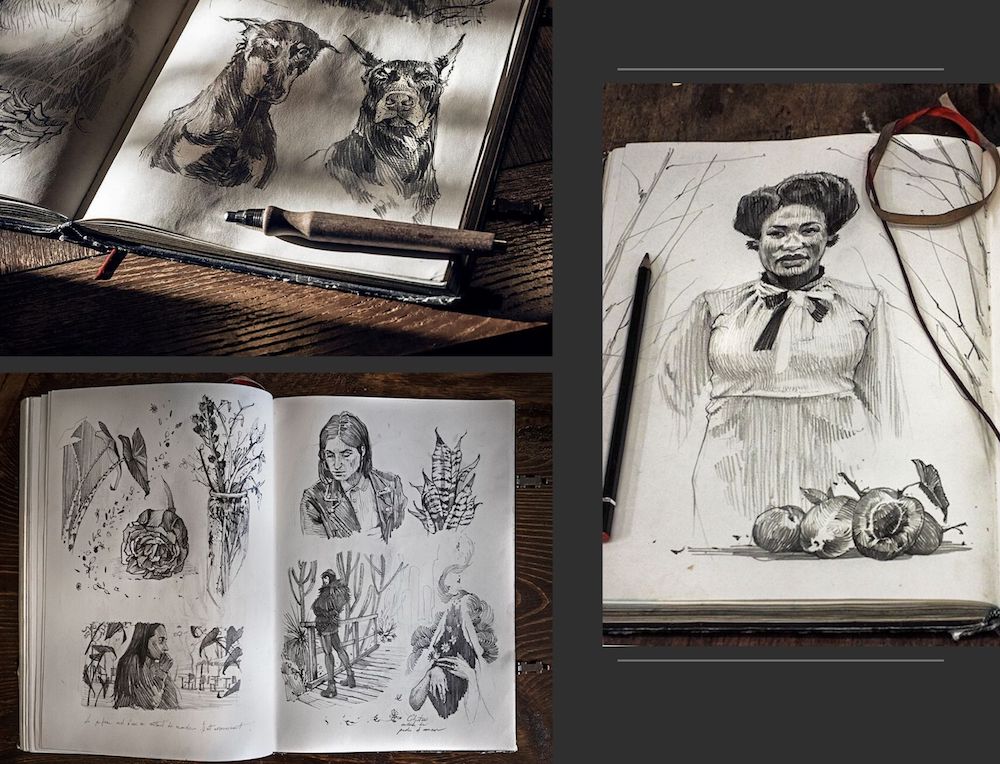
2. How did you get into painting?
I started painting because I was introduced to drawing when I was maybe 12 years old. For me, it was the next step. For many years, I was able to draw but unable to use colours and understand them. It’s really complicated to dialog with colours when you have drawn in black and white since you were four years old. I bought my first canvas and an easel, and I started with acrylics. The beginning was frustrating. At the same time, I started to meet people from the graffiti scene in Avignon, south of France. Graffiti artists have a great way of working when it comes to colours – they are kind of academic painters from the street, they know a lot of things without being aware of it. I was beginning to understand harmony, associate pale tones to strong colours, mix cool tones with warm tones. During my art studies many years later I finally met a great painter, Ludovic Bottosso, who taught me the importance of colours and how to mix them as a real academic painter from the 19th century. This fusion of learning between street culture and academic culture gave me a good start.
3. How would you describe the subject matter of your work?
Create fiction with few elements. When a lot of things are happening in a frame, you can’t see it, but you know it, as in cinema or photography. A particular light, for example, connects to a simple tree, a landscape, an object or a portrait from the back. I’m an aesthetician who can find a lot of beauty everywhere. Feelings and emotions can be created when you associate anecdotal things together. Portraits and especially women are also an important part of my work – they intimidate me as much as they fascinate me. And just through a look you can easily feel a hundred different emotions. Try to paint and draw, this is an amazing exercise to better understand human emotions and behaviour.
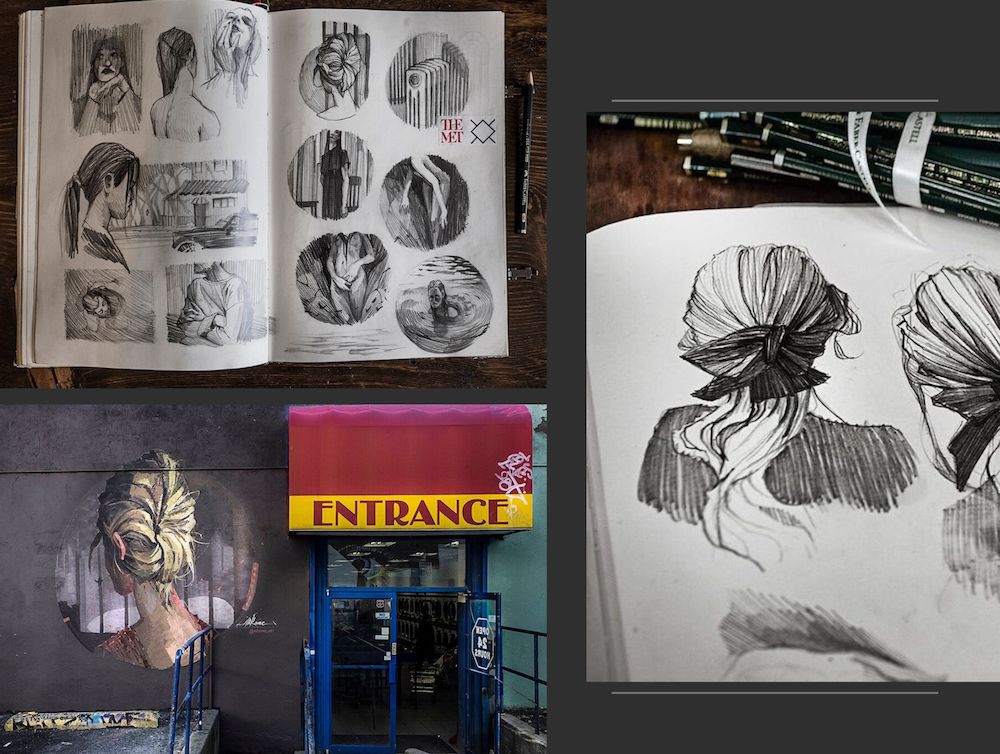
4. I see that you are a painter and muralist, as well as an accomplished photographer. Which is your favourite medium to work with?
For me these three mediums are actually one. I cannot dissociate any one from another, because the three of them give me the possibility to create something: a picture. I often start to work from a picture I stole from reality, like a screenshot from an old movie or a picture of my sister laughing at dinner. I also take a lot of video when I find something beautiful, then I press stop and decide to paint it. Sometimes I imagine a new context and choose another light to express something else; something in the scene is already a painting before painting it. Like when something crazy happens and you thought it was only happening in a movie, I see my daily life as an empty canvas waiting to see what will happen to paint it.
5. Who are your biggest influences?
I’ve got many influences, from many different things. In terms of technique, I would say Impressionism, the Genre scene, or the Pictorialism movement in photography. I also love the aesthetic in cinema, like the works of Hélène Cattet and Bruno Forzani who took their own influences from the Giallo movies. I’m impressed by the sensibility of the cineaste Andrei Tarkovsky, also in love with the work of the photographer Deborah Turbeville, the breathtaking portraits of painter J. Singer Sargent. So yes, influences from painting, cinema and photography. On most of them there is a kind of melancholic tonality and poetic scene featuring women.
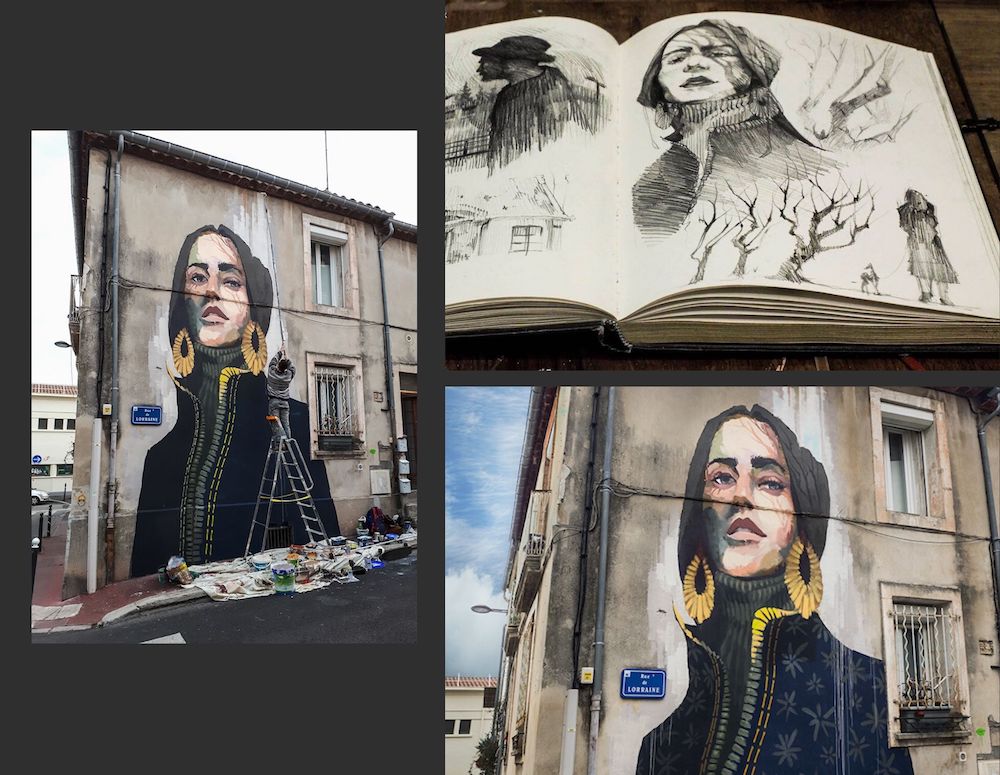
6. What are you currently reading, listening to or looking at that fuels your work?
I’m currently reading one of the first versions of Alice in Wonderland, published in 1898. It’s an antique book I found in an antique bookstore on the internet – a red cloth cover with the cat engraved in gold; this book was illustrated by John Tenniel. It’s an awesome piece, really inspiring, which helps me to improve my English. I’m listening to music a lot, and also making a video of my confinement with my roommate. I think it’s important to do something else than what you do every day to develop your creativity. Even the way you cook a simple onion can show a part of your creativity, so my fuel for work is just living.
7. Can you tell us about your creative process, from sketchbook to mural?
Conversely, this process is almost mechanical and mathematical. When I make a big wall and have to reproduce a 4×6-inch sketch, it’s more about finding a way to put the right proportion on the wall than creativity. You already did the job when you were sketching, so now the exercise is keeping the strength of the design and avoiding mistakes. When the wall is oversized, I draw a grid with my pole. I systematically use a pole to paint the walls – it’s funny how I translate my little pencil sketch with this tool that is not really appropriate.
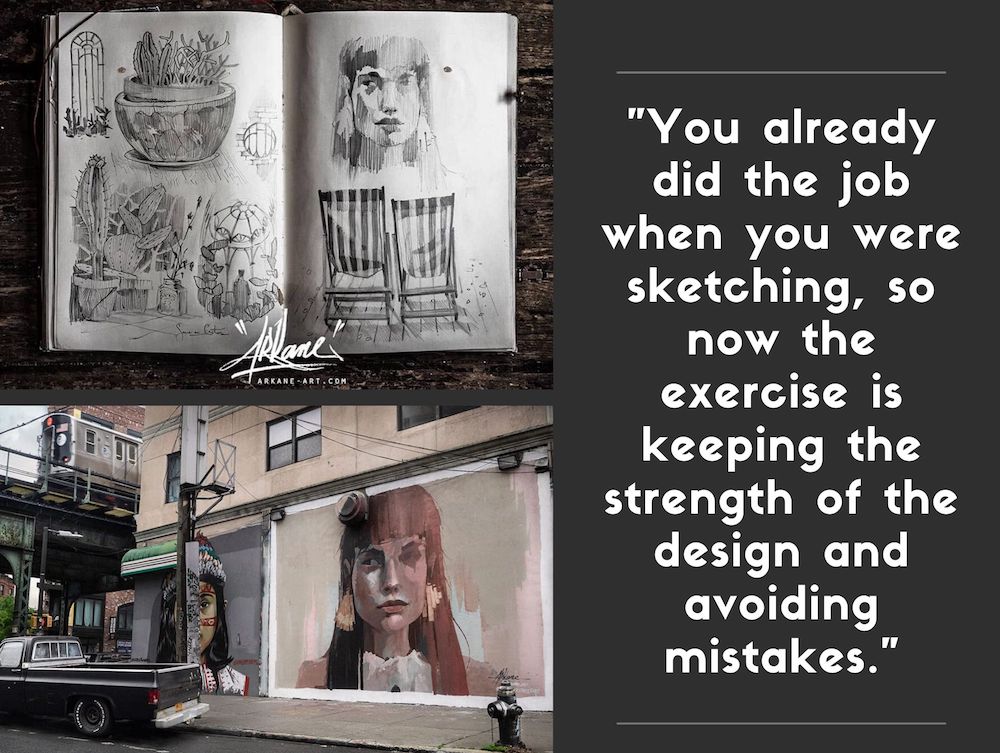
8. You have travelled to several places to work on mural projects. How has it been to bring your artwork to other countries and cultures?
This is really exciting. It is a great way to meet people and create a bridge between cultures. Pictorial art, more than anything, is one of the most accessible forms of art. 30,000 years ago people were already drawing in their own cavern, so we have this in common. It’s somewhere in our blood regardless of our countries. There is something fascinating in this exercise, and wherever I’ve been, this art has always interpolated and that’s how we start a conversation. There is a bit of egocentrism, putting “a part of you” somewhere, where no one has expected you. I guess this is a heritage from the graffiti and philosophy of writers. Whatever your motivation, for me, I do my best. And for each wall I do, I choose pattern and colours that most of the time reflect the culture of the country I am in (i.e., the wall in Serbia with eastern patterns and a cool palette, or the tower in Mexico with traditional dress). It’s important for me to make something personal, but I like it even more when a stranger can identify themselves and are proud of their wall in their neighbourhood.
9. What kind of role do you see street art having in urban society today?
I was talking about a bridge between culture so I guess it’s an undissociated part of this art, and also an art for everyone whatever the topic. Sometimes it can be disturbing, naive, historical or political or just decorative. The role is to speak to people and question them on their own convictions. What do you think? Do you like it? Do you hate it, and why? Why is this disturbing you or making you shiver? This art is an open-air museum where you didn’t choose to buy a ticket, and I guess it contributes a lot to educate the perspective of people, of what they like or dislike, and allowing them to form their own opinion on this question is an important thing nowadays. As well as to bring them back to the question of identity, Who am I?
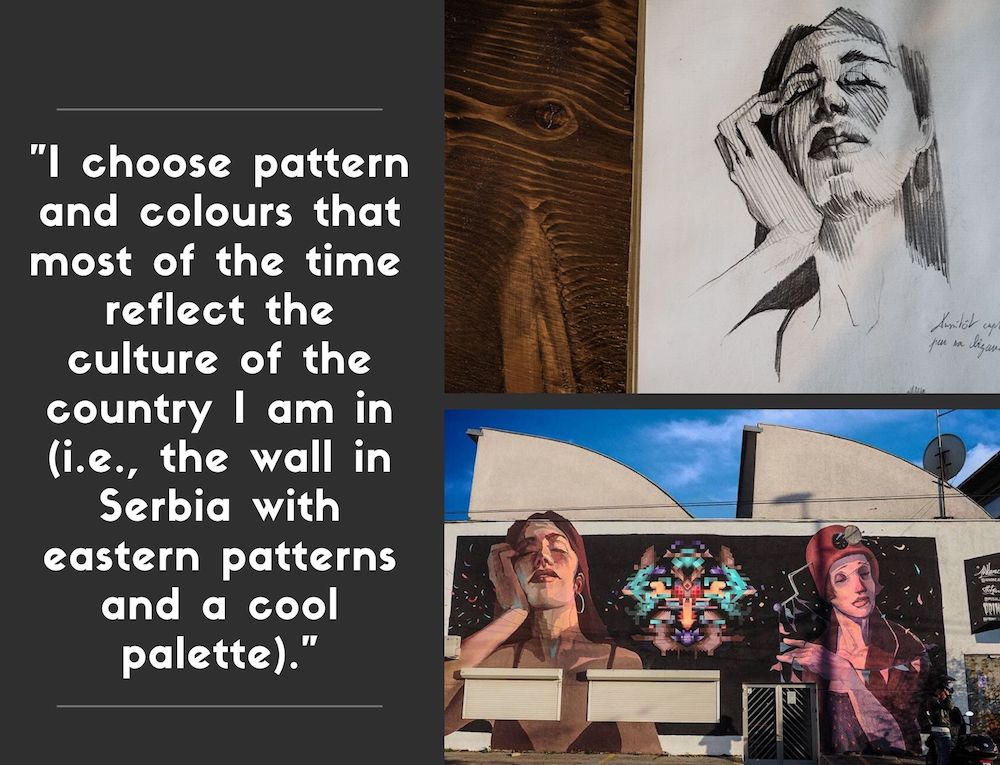
10. How is art helping you cope during this unprecedented time?
Art has been my therapy in everyday life since I was four years old. It’s funny because during these strange times I could be more productive but I’m not really. I spend most of my time in my kitchen or with my roommate playing cards and taking care of my plants. I’ve discovered another life based on simple things and these activities enthuse me even more than going to paint a canvas. Of course, my studio is five minutes from home, and I can go to work there whenever I want, I’m lucky that way, but I have to say that I appreciate this slowdown and it will hopefully benefit our society. Anyway, I miss my friends and can’t wait to sit under a sunny terrace with a martini. Good luck everyone, take care of you and thanks for reading!
If you want to learn more about Arkane’s work, visit www.arkane-art.com or @arkane.art on Instagram.





